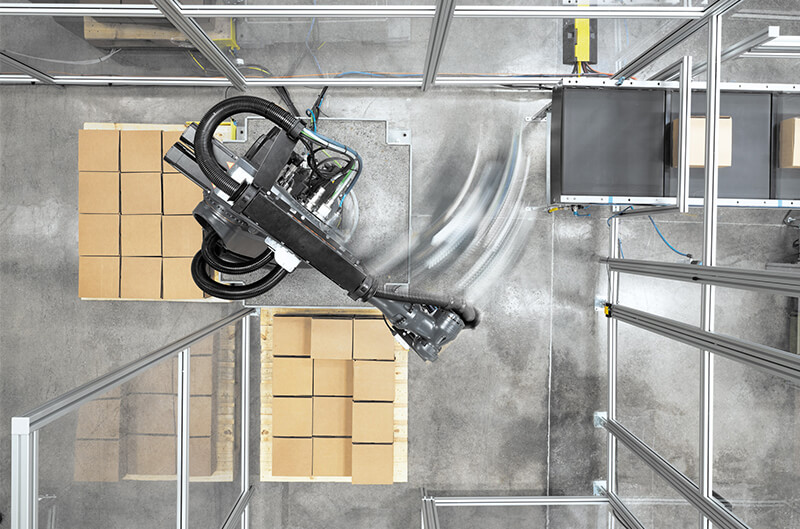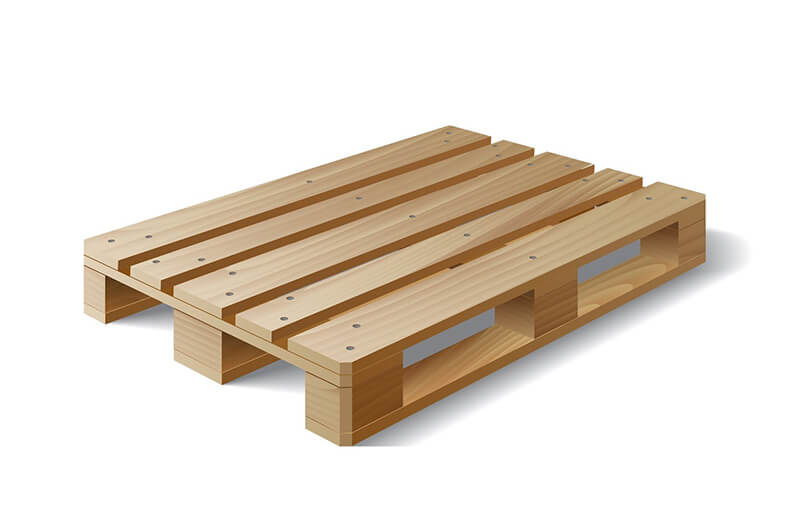The Advantages of Using Robotic Palletizing for Your Business
Moving products onto and off of pallets has traditionally been done by hand. New robotic palletizing machines make this faster, safer, and more accurate.
Posted April 2022 Back to Resources
The Advantages of Using Robotic Palletizing for Your Business
Palletizing has long been one of the more dangerous and expensive—though necessary—functions in warehouse packaging operations. However, robotic palletizing is here to change the game. Robots are creeping into use in every facet of life. But when it comes to palletizing, when they can save money, injury, and time, the upgrade is a near necessity to update your operations for the future.
Robotic palletizing replaces costly and unsafe manual handling of packages on pallets with smart machines. Robots can handle more weight faster, with fewer costs and other requirements. Now that we’ve developed robots smart enough to handle this task without hassle, their adoption just makes sense, from a business standpoint.
As an example, Amazon has cut operating costs by a fifth with the use of these “cobots,” collaborative robots that work with humans. This results in savings of around $22 million for each fulfillment center—adding up to hundreds of millions saved for the company as a whole
Globally, the market for robotic palletizers is expected to grow at a rapid 13% compound annual rate over the coming years. Businesses are automating their processes, streamlining operations for e-commerce, retail, pharmaceuticals, electronics, food and beverage, and many other industries. Robotic palletization can contribute to your company’s operations too.

What is Robotic Palletization?
Robotic palletization, quite simply, is the loading and unloading of pallets with automated machines. The devices include an arm for moving products onto or off of the pallets and different tools for grabbing specific products.
In the robotic palletization process, the arm selects each item and places the product precisely where it should go. Robotic palletizers can handle objects of highly varying size, shape, weight, and consistency, making them far more sophisticated in their operations than previous automated solutions.
The Benefits of Using a Robotic Palletizer
Regardless of which robotic palletizer one uses, they offer several advantages over manually stacking. For example, robotic palletization alleviates the risk of serious injuries to workers. Lifting heavy weights risks any number of back injuries, such as strains and sprains. Robots, meanwhile, can effortlessly transport large objects. The machines have greater accuracy than humans, decreasing the number of wrongly-located or broken products.
Robotic palletizing also runs considerably faster than manual labor. The machines operate at a consistent speed all the time, not requiring the same pauses and work conditions as human laborers. They cost less, too. Human labor is expensive, especially in today’s market. The financial savings free people to work on more interesting activities with their time.
Looking at the bigger picture, robotic palletizers give businesses the reliability of a stable workforce. This is all the more important in the current environment. With labor woes affecting employers, robots offer the security of consistent performance. They don’t run the risk of not turning up on certain days. Furthermore, during peak periods when it’s difficult to hire seasonal workers, robotic palletizers can be added as necessary.
Robotic palletizers just work more effectively. They fit products with excellent precision, handling cartons, trays, bottles, or any other container safely and efficiently. Given the advantages of using a robotic palletizer, businesses often find that they experience substantial increases in morale and earnings after switching to them.
How Neuroscience-Inspired AI Works With a Palletizer
The technology behind robotic palletizers has undergone dramatic developments in recent years, with new neuroscience-inspired AI available in top-of-the-line machines from Vicarious. This software controls the palletizer through advanced mental models that mimic the human mind.
While older palletizers rely on simple software that can only handle straightforward stacking, the new neuroscience-inspired AI instead has the know-how to perform mixed palletizing, with complex product arrangements. Even when products differ substantially in size and other traits, the robots find efficient packing methods.
Thanks to the smart control code and elegant design, Vicarious palletizers can manage difficult loads without the need for fixturing. Without the need for many conveyors as in conventional palletizers, the new machines decrease the costly space requirements. Also, you can easily install more robots if you need more capacity. These upgraded palletizing processes allow businesses to send out mixed pallets with more accuracy and less expense, while also eliminating costly scans and shipping errors.
Types of Robotic Palletizing Systems
There are several different types of robotic palletizing systems available on the market. Each type serves a different use, so it’s important to understand which works best for your operations.

Inline Palletizing
Inline palletizers move products in a line towards the machine. The robot operates on the same timing as the products traveling towards it, and grippers have shapes that match up precisely with the products. Inline palletizing is particularly useful for rapid processes, such as packaging drink containers in the beverage industry.
Layer Palletizing
Layer palletizers use a pair of rubber rollers to apply pressure to opposite sides of product packages, adjusting the exact pressure and location to individual products. The system squeezes products onto plates to be carried to pallets.
Layer palletizing works well for situations with multiple different product types that may stymie simpler systems. As an example, a facility may process open trays, shrink-wrapped products, and corrugated cardboard boxes. These robots can adjust to each object on the fly.
Layer Freezer Palletizing
Layer freezer palletizing robots use vacuum and clamping grippers to collect products. They operate similarly to regular layer palletizers, but are adapted to function in cold conditions, as they work on frozen food products.
Handling frozen products had traditionally required manual labor. High-turnover workforces in these cold workplaces have made palletizing difficult, but robotic solutions can come to the rescue.
Mixed Case Palletizing
Mixed case palletizers operate with a robotic arm that can reach any location or angle to grab products. These robots assemble pallets regardless of whether you have vases, open trays, closed trays, totes, or any other product configurations.
Mixed case palletizing works for extremely complex situations, such as when you need to select from many different products on demand. The quality of the control software matters with mixed palletizing, and neuroscience-inspired AI like Vicarious enables the most advanced mixed case palletizing on the market.
Innovate Your Business Processes With Robotic AI Solutions
Robotic palletization prevents worker injuries, makes packing faster and less expensive, and increases accuracy. Why wouldn’t you want to upgrade your business this way? Vicarious palletizer robots, with their next-level artificial intelligence, present the next step in warehouse packaging operations. And the Robots-as-a-Service (SaaS) model means you only pay for productive output by the robots, when you need them—parts and maintenance included. Scale up and down the number of robots you need as your demand changes.
Ready to innovate? Contact Vicarious now!
